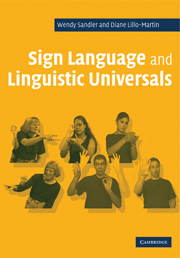Book contents
- Frontmatter
- Contents
- Preface
- Notation conventions
- UNIT I INTRODUCTION
- UNIT II MORPHOLOGY
- UNIT III PHONOLOGY
- UNIT IV SYNTAX
- 17 Syntax: introduction
- 18 Clausal structure
- 19 Clausal structure across sign languages
- 20 Variations and extensions on basic sentence structures
- 21 Pronouns
- 22 Topic and focus
- 23 WH-questions
- 24 Syntax: summary and directions
- UNIT V MODALITY
- References
- Index
19 - Clausal structure across sign languages
Published online by Cambridge University Press: 05 June 2012
- Frontmatter
- Contents
- Preface
- Notation conventions
- UNIT I INTRODUCTION
- UNIT II MORPHOLOGY
- UNIT III PHONOLOGY
- UNIT IV SYNTAX
- 17 Syntax: introduction
- 18 Clausal structure
- 19 Clausal structure across sign languages
- 20 Variations and extensions on basic sentence structures
- 21 Pronouns
- 22 Topic and focus
- 23 WH-questions
- 24 Syntax: summary and directions
- UNIT V MODALITY
- References
- Index
Summary
We have seen that despite the fact that there is considerable flexibility of word order, ASL can be described as a language with the underlying or basic word order SVO. Typically, an SVO language (like English) has the ordering head–complement for all phrasal categories. While it is clear that ASL employs this ordering for some categories, there have been various proposals for some kind of mixed headedness to account for the full range of surface orders observed. These proposals were discussed in Chapter 18, but they will come up again as we discuss additional aspects of order-changing operations in Chapters 20 and 22.
While a number of researchers have proposed that languages may vary in their headedness, and even in the hierarchy of functional projections employed, others support an analysis which restricts the possible variation in these domains. Perhaps the most strictly restricted theory is that of Kayne (1994). Kayne proposes that all languages have the same underlying phrase structure, and that this structure requires the order specifier before head, head before complement. If a language has the surface order complement–head, then this order must be derived, on Kayne's theory.
Given the proposals for mixed headedness in ASL, is it possible to apply a theory like Kayne's to account for ASL data?
In this chapter, we will address this question. But, since Kayne's proposal is about where cross-linguistic variation is found, it will be most informative for us to consider the question in the light of cross-sign-language data.
Information
- Type
- Chapter
- Information
- Sign Language and Linguistic Universals , pp. 320 - 333Publisher: Cambridge University PressPrint publication year: 2006
